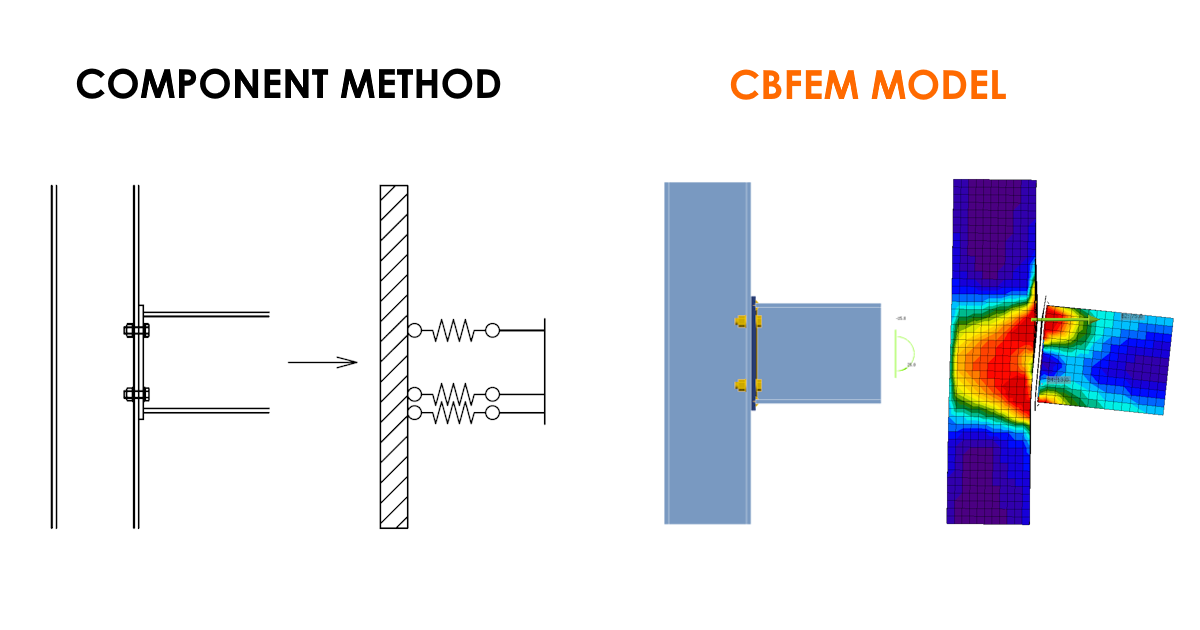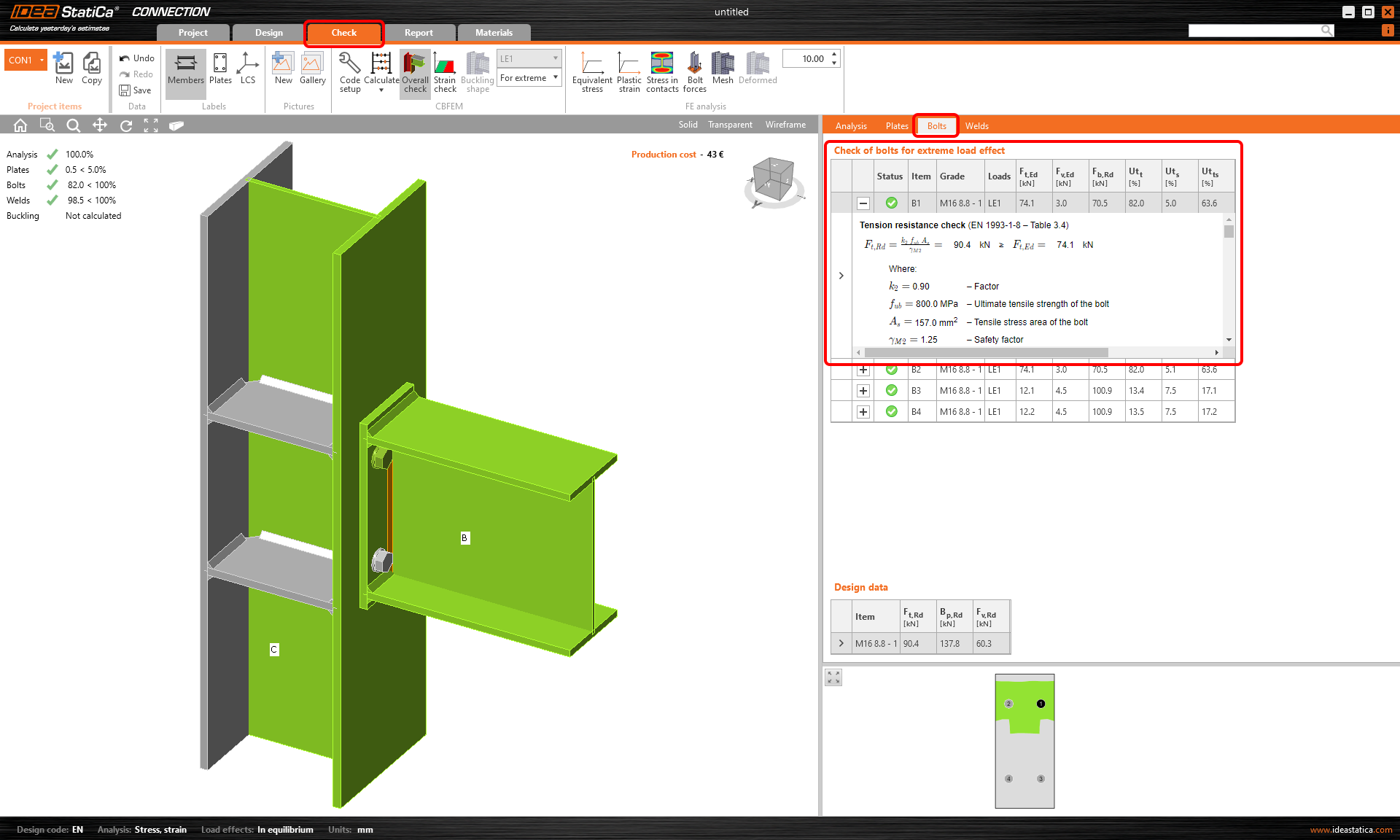CBFEM - how it works, code compliance, validation and verification
CBFEM is a unique method for the design and code-check of steel connections, members, and anchoring. It can be used for the majority of joints, anchoring, and details with various topologies.
Component Based Finite Element Method (CBFEM) method is:
- General enough to be usable for most of the joints, footings, and details in engineering practice.
- Simple and fast enough in daily practice to provide results in a time comparable to current methods and tools.
- Comprehensive enough to provide structural engineers with clear information about joint behavior, stress, strain, reserves of individual components, and about overall safety and reliability.
The check of a joint in a standard component based method and in the CBFEM used in IDEA StatiCa Connection is based on the check of all parts of the joint – the components. Components can be bolts, anchors, welds, plates, and concrete at the footing.
CBFEM splits the whole joint into above mentioned separated components. Then the analysis model is created automatically by the software from each component.
The check itself consists of two steps:
- Forces in each component of the joint are calculated
- Each component is checked using the code equations
Calculation of forces
The CBFEM implemented in IDEA StatiCa Connection makes the behaviour of each component simpler. How?
The model consists of members to which the load is applied and manufacturing operations (including stiffening members), which serve to connect members to each other.
The analyzed FEM model is generated automatically. The designer does not create the FEM model, they create the joint using manufacturing operations.
Thanks to that, forces are calculated without simplifying presumptions. And the other effects, like the interaction of the components, etc., are calculated too.
Moreover, because of the consideration of the real stiffness of the components, the results include prying. Nothing is neglected.
Check and results' evaluation
Strength analysis is the most important analysis of joints. Strain checks of plates together with code checks of components are performed by elastic-plastic analysis.
The analysis of joints is materially non-linear. The load increments are applied gradually, and the state of stress is searched.
Check of plates
The plates are modeled with elastic-plastic material with a nominal yielding plateau slope according to EN 1993-1-5, Par. C.6, (2), tan-1 (E/1000).
The material behavior is based on the von Mises yield criterion. It is assumed to be elastic before reaching the design yield strength fyd.
The ultimate limit state criterion for regions not susceptible to buckling is reaching the limiting value of the principal membrane strain. A value of 5 % is recommended (e.g. EN 1993-1-5, App. C, Par. C.8, Note 1).
Specific parts of the Theoretical Background for each of the supported national standards:
- Code-check of plates according to EN (Eurocode)
- Code-check of plates according to AISC (American standard)
- Code-check of plates according to CISC (Canadian standard)
- Code-check of plates according to AS (Australian standard)
- Code-check of plates according to IS (Indian standard)
- Code-check of plates according to GB (Chinese standard)
- Code-check of plates according to HKG (Hong Kong Code of Practice)
- Code-check of plates according to SP (Russian standard)
Check of other components
The checks are performed for the calculated forces by the same equations as in the code in all methods. Equations used for the bolts, anchors, welds, and concrete block are presented in the application, and can be thoroughly reviewed.
Bolts check
Bolts in IDEA StatiCa Connection are checked according to corresponding standards. For more information, read the Bolts and bolted connections article.
Welds check
Also in the case of welds, the check is done according to corresponding codes.
Detailed information about welds check in the Connection application can be found in the Weld/Welds in IDEA StatiCa article.
Concrete block check
The principles behind the concrete block's calculation are explained in the Structural model of a concrete block article.
Specific parts of the Theoretical Background for each of the supported national standards:
- Code-check of a concrete block according to EN (Eurocode)
- Code-check of a concrete block according to AISC (American standard)
- Code-check of a concrete block according to CISC (Canadian standard)
- Code-check of a concrete block according to AS (Australian standard)
- Code-check of a concrete block according to IS (Indian standard)
- Code-check of a concrete block according to GB (Chinese standard)
- Code-check of a concrete block according to HKG (Hong Kong Code of Practice)
- Code-check of a concrete block according to SP (Russian standard)
How can CBFEM be compliant with the code and real behaviour at the same time?
Design-oriented FEA (CBFEM) is optimized to deliver results relevant for code-check while covering the real structure's behaviour. At the same time, it considers the safety margin defined by the code.
Watch the video and find the answer to your questions.
Key features of CBFEM analysis
Have you ever heard the acronyms MNA or GMNA implemented in the software, but you're unsure what they mean? The properties of the analysis, the nonlinearity of the material, or geometry. What is recommended and performed by CBFEM?
Check the following video and learn about the approaches.
Validation and verification
Originally, two university teams had spent over three years on the verification and validation of the CBFEM method.
Over time, multiple new verification studies have been run in cooperation with universities from all around the world (USA, Netherlands, Germany, Switzerland, South America, and more).
What exactly do validation and verification mean? The validation and verification process confirms that the results of the software are correct.
Verification is a comparison to an analytical method, most often incorporated in the building code (e.g. AISC, EN, etc.).
Analytical methods in codes are weighed down by simplifications, and the results between the code and the CBFEM for complicated connections may vary, especially at the boundaries of the range of validity. In that case, a comparison of CBFEM to an advanced model validated by experiments proves that CBFEM is safe even though the resistances are higher than determined by the code.
Validation is a comparison of a numerical model to an experiment.
The numerical model is often highly advanced, including material and geometrical nonlinearities. The geometry and material properties are the same as those measured in the experiment. When the results – typically a load-displacement and stress-strain curves – of the numerical model are close to those of the experiment, the numerical model is validated. The material properties of the numerical model are then changed to nominal values, imperfections are increased according to manufacturing tolerances, and several sensitivity studies may be performed by changing parameters, e.g. thickness of plates, yield strength of the material.
Finally, the results of the numerical model are compared to those of CBFEM. The results do not need to coincide perfectly, but the results must be safe and the differences in an acceptable range.
The most important verification and validation examples were published in the book "Component-based finite element design of steel connections."
In our Support Center, you can find many verification studies as well as comparisons to laboratory tests. Find them using the link below.




